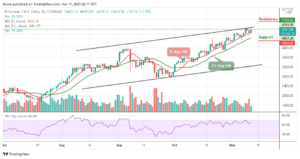After several months of major payroll disappointments, the BLS finally realized it has to come up with a strong number and it did just that moments ago when it reported that in June the US added 850K jobs, well above the 720K expected, and almost 50% more than last month’s 583K, in a welcome sign that the chronic labor shortages may finally be ending.
Yet a question immediately emerges: while the Establishment survey shows a gain of 850K, the household survey shows that the number of employed was actually down by 18K. As Bloomberg’s Chris Antsey writes, “the question for me is why the big discrepancy between the household survey showing a decline in employment and the payroll figures showing a pick-up in job growth. Other data, including the ADP survey of private-sector payrolls earlier this week, suggest a strengthening job market.”
Despite the stronger than expected monthly increase, the US is still 7.6 million people below its pre-Covid level.
Below are all the key details from today’s report:
- Nonfarm payrolls rose 850k vs prior 583k in prior month (net revisions +15k from prior two months)
- Nonfarm private payrolls rose 662k vs prior 516k; est. 615k (450k to 1000k); 34 economists surveyed
- Manufacturing payrolls rose 15k after rising 39k in the prior month; economists estimated 25k (20k to 40k); 14 economists surveyed
- Avg. hourly earnings 0.3% m/m, est. 0.3%; prior 0.4%; Y/y 3.6%; est. 3.6%
- Unemployment rate 5.9% vs prior 5.8%; est. 5.6% (5.5%-5.8%); 73 economists surveyed
- Participation rate 61.6% vs prior 61.6%
While average hourly earnings came in right on top of expectations, rising 3.6% Y/Y, the unemployment rate rose from 5.8% to 5.9%, missing expectations of a drop to 5.6% as the number of unemployed workers rose from 9.316MM to 9.484MM while the labor force was largely unchanged. In fact, as shown below the unemployment rate rose across all races:
The Labor force participation rate of 61.6% was unchanged from last month, and just below the 61.7% expectation.
Looking at prior month revisions, the change in total nonfarm payroll employment for April was revised down by 9,000, from +278,000 to +269,000, and the change for May was revised up by 24,000, from +559,000 to +583,000. With these revisions, employment in April and May combined is 15,000 higher than previously reported.
As noted above, average hourly earnings rose 0.3% sequentially and 3.6% Y/Y up from 1.9% last month, both in line with expectations, as the labor market appears to be stabilizing especially at the low end.
Specifically, average hourly earnings for all employees on private nonfarm payrolls rose by 10 cents to $30.40 in June, following increases in May and April (+13 cents and +20 cents, respectively). Average hourly earnings of private-sector production and nonsupervisory employees rose by 10 cents to $25.68 in June. As the BLS notes, “the data for recent months suggest that the rising demand for labor associated with the recovery from the pandemic may have put upward pressure on wages.”
Well, of course, but another reason for the increase in average earnings is that the average workweek for all employees decreased by 0.1 hour to 34.7 hours. In manufacturing, the average workweek fell by 0.2 hour to 40.2 hours, and overtime declined by 0.1 hour to 3.2 hours. The average workweek for production and nonsupervisory employees on private nonfarm payrolls declined by 0.2 hour to 34.1 hours.
According to Bloomberg’s Carl Riccadonna, “incomes are rising, to be sure, but the pace is decelerating–and combined with surging inflation in general (and gasoline prices in particular)–if sustained, this could marginally dampen retail/consumer spending prospects in the back half of the year. Rebate checks and savings can prop up spending in the interim, but the makings of a 2H moderation are starting to materialize.”
Broken down by industry, notable job gains in June occurred in leisure and hospitality, public and private education, professional and business services, retail trade, and other services.
- Employment in leisure and hospitality increased by 343,000, as pandemic- related restrictions continued to ease in some parts of the country. Over half of the job gain was in food services and drinking places (+194,000). Employment also continued to increase in accommodation (+75,000) and in arts, entertainment, and recreation (+74,000).
- Employment rose by 155,000 in local government education, by 75,000 in state government education, and by 39,000 in private education, or a total of 269K new teachers! In both public and private education, staffing fluctuations due to the pandemic, in part reflecting the return to in-person learning and other school-related activities, have distorted the normal seasonal buildup and layoff patterns, likely contributing to the job gains in June. (Without the typical seasonal employment increases earlier, there were fewer layoffs at the end of the school year, resulting in job gains after seasonal adjustment.) These variations make it more challenging to discern the current employment trends in these industries.
- Employment in professional and business services rose by 72,000 in June but is down by 633,000 since February 2020. In June, employment rose in temporary help services (+33,000), advertising and related services (+8,000), scientific research and development services (+7,000), and legal services (+6,000).
- Retail trade added 67,000 jobs in June, but employment is down by 303,000, or 1.9 percent, since February 2020. Over the month, job growth in clothing and clothing accessories stores (+28,000), general merchandise stores (+25,000), miscellaneous store retailers (+13,000), and automobile dealers (+8,000) was partially offset by losses in food and beverage stores (-13,000) and health and personal care stores (-7,000).
- The other services industry added 56,000 jobs in June, with gains in personal and laundry services (+29,000), in membership associations and organizations (+18,000), and in repair and maintenance (+9,000).
- Employment in social assistance rose by 32,000 in June, largely in child day care services (+25,000). Employment in social assistance is down by 236,000 from its level in February 2020.
- In June, wholesale trade added 21,000 jobs, with gains in both the durable and nondurable goods components (+14,000 and +9,000, respectively).
- Employment in mining rose by 10,000 in June, reflecting a gain in support activities for mining.
- Employment in manufacturing changed little in June (+15,000). Within the industry, job gains in furniture and related products (+9,000), fabricated metal products (+6,000), and primary metals (+3,000) were partially offset by a loss in motor vehicles and parts (-12,000).
- Employment in transportation and warehousing was little changed in June (+11,000). Employment gains in warehousing and storage (+14,000), air transportation (+8,000), and truck transportation (+6,000) were partially offset by a loss in couriers and messengers (-24,000).
- Construction employment changed little in June (-7,000). Over-the-month job losses in nonresidential specialty trade contractors (-15,000) and heavy and civil engineering construction (-11,000) were partially offset by a gain in residential specialty trade contractors (+13,000).
According to BI Economics’ tabulations, the ‘vulnerable to lockdown’ categories added 493k jobs (of which 343k were in leisure and hospitality), whereas the ‘less vulnerable’ industries added 357k jobs, compared to a 3-month trailing average of 160k. In short, according to Bloomberg, “this is not just ‘re-opening hiring,’ today’s report reflects a real improvement in underlying economic fundamentals.”
Commenting on the data, Bloomberg writes that the non-farm payrolls print for June, while better-than-forecast, is still within the ballpark of expectations: “As such it is unlikely to fire up the market’s imagination as it doesn’t suggest “substantial further progress” in labor-market improvement. This print argues for yields to tread water with a downward bias and for stocks to continue to be supported.” At the same time, the unemployment rate was higher than forecast, “which will worry the Fed. Various Fed speakers have outlined in recent weeks that employment may be as much as 10 million below pre-Covid levels, and the data for June marks incremental progress without suggesting any quantum leap. In other words, there is no impetus to push the taper time line forward.”
In short: mostly goldilocks, thanks to notable job gains in leisure and hospitality, teaching, professional and business services, retail trade, and other services. But the jobless rate rose 0.1% to 5.9%, and avg hourly earnings only met consensus because workweek hours were down. .
- "
- 000
- 2020
- 39
- 67
- 7
- 9
- accessories
- activities
- Advertising
- All
- April
- Arts
- AVG
- BEVERAGE
- Bloomberg
- business
- care
- change
- Checks
- child
- Clothing
- Consensus
- construction
- continue
- Current
- data
- day
- Demand
- Development
- DID
- Drop
- Earnings
- Economic
- Education
- employees
- employment
- Engineering
- Entertainment
- Fed
- Finally
- Fire
- food
- Forward
- Fundamentals
- General
- goods
- Government
- Growth
- Health
- Hiring
- hospitality
- household
- HTTPS
- image
- Including
- Increase
- industries
- industry
- inflation
- IT
- Job
- Jobs
- Key
- labor
- LAYOFF
- layoffs
- learning
- Legal
- Level
- Line
- local
- Local Government
- major
- manufacturing
- Market
- metal
- million
- Mining
- months
- net
- offset
- Other
- pandemic
- People
- pressure
- private
- Production
- Products
- public
- Quantum
- recovery
- report
- research
- research and development
- retail
- retailers
- School
- Scientific Research
- Services
- Short
- shortages
- Social
- speakers
- Spending
- State
- Stocks
- storage
- store
- stores
- support
- Supported
- Survey
- Teaching
- temporary
- time
- top
- trade
- transportation
- Trends
- truck
- unemployment
- us
- Vehicles
- Warehousing
- Water
- week
- wholesale
- within
- words
- workers
- year







